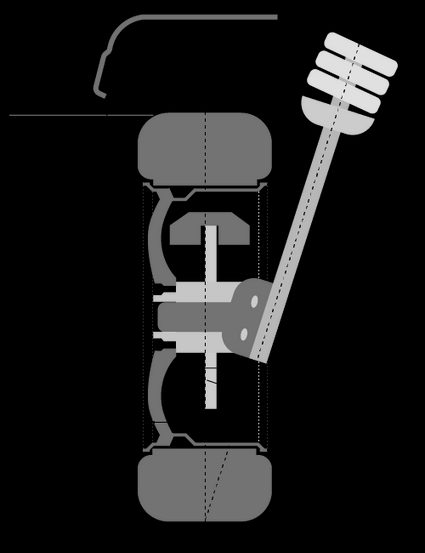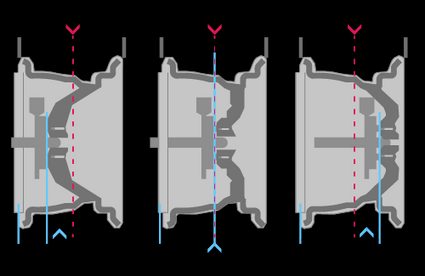Wheel Offset Calculator
This wheel offset calculator will help you determine the wheel offset for your vehicle. When you change the wheels of your truck or car to make customizations, they are often not the same width or size as the ones coming from the original manufacturer. Such wheels or tires are aftermarket wheels. Picking a tire with a larger or smaller diameter can cause errors in the speedometer. If you are switching between tire sizes, check out our speedometer gear calculator.
Changing the wheel with a different width might provide you with a better friction (learn more from our friction calculator) but consume a bit more fuel (learn more from our fuel consumption calculator). It is also necessary to check for the contacts with the fenders and the brake pads that might need adjustments by offsetting to avoid interferences.
If you are looking to rig your ride with a new set of aftermarket wheels, you must first understand what wheel offset means. You can use this tool for wheel offset comparison, and the article below will help you know how the wheel offset works and how to measure it.
What is wheel offset — What does wheel offset mean?
Before we go into wheel offset, let's understand the basic terms concerning the setup.
- Declared width or rated width — Width of the bead seat where the tire sits on the wheel. The rims have lips or walls on either side. The width is the inner distance between those walls.
- Overall wheel width — Complete width of the wheel, including the walls or flanges on either side of the wheel.
- Centreline — Line at the center of the wheel. In other words, the line divides the cross-section of the wheel into two halves.

The wheel has a mounting pad that is aligned and mounted on the hub of the car. The wheel offset is the distance between the mounting pad and the centerline of the rim. You can use the width and offset of two wheels to find the change in clearance and the position. Mathematically the clearance change is:
where:
- – Width of current wheel;
- – Width of new wheel;
- – Offset for current wheel; and
- – Offset for new wheel.
Similarly, the change in position is:
A positive offset means the wheel is more outward and away from the suspension, whereas the negative offset means the wheel is closer to the suspension.

How to calculate wheel offset for wheel change
To calculate wheel offset for wheel change:
- Enter the width of the current wheel.
- Fill in the offset for the current wheel.
- Insert the width of the new wheel.
- Enter the offset for the new wheel.
- The wheel offset calculator will return the change in clearance and the position of the wheel.
Example: Using the wheel offset calculator
Calculate the wheel offset for the new arrangement using the following data:
Wheel | Width | Offset |
|---|---|---|
Current | 7 in. | 42 mm |
New | 8 in. | 32 mm |
- Enter the width of the current wheel as
7 inchesor177.8 mm. - Fill in the offset for the current wheel as
42 mm. - Insert the width of the new wheel as
8 inchesor203.2 mm. - Enter the offset for the new wheel as
32 mm. - The change in clearance is:
- The change in position is:
Since the position and clearance are negative, the new wheel is closer to the suspension by 22.7 mm, i.e., it is has reduced the clearance (< 0) by 2.7 mm. The position change and clearance change tell the user how much the new wheel will affect the existing values, and therefore, they can make the adjustments as such.
FAQs
What do you mean by wheel offset?
The wheel offset is the distance between the centerline of the wheel and the mounting surface or pad of the wheel. The offset can be positive, negative, or zero based on the position of the mounting pad on either side of the centerline or at the centerline.
How do I calculate clearance change?
To calculate wheel offset:
- Subtract the wheel width for the new wheel from the current wheel.
- Divide the difference by two to find the difference between the centerlines.
- Find the difference between the offset of both wheels.
- Add the resultant to the difference between centerlines to obtain the change in clearance.
What do you mean by wheel backspacing?
The wheel backspace refers to the distance between the wheel's mounting pad or mounting surface and the inner lip or flange. It depicts the location of the mounting pad with respect to the wheel width and changes with increase or decrease in the wheel width.
What are the type of offsets?
A wheel offset could be either positive, negative, or zero. A zero offset means the mounting hub and the wheel's centerline are aligned or have zero distance between them. The negative and positive offset means the mounting hub of the wheel is towards or away from the suspension.
What is the clearance for wheels width and offsets having a difference of 2 mm?
For a difference of 2 mm between the wheel widths, and offsets, the clearance change is 3 mm. Mathematically, the given wheel change is given by the equation:
Clearance = 2/2 + 1 = 3 mm.